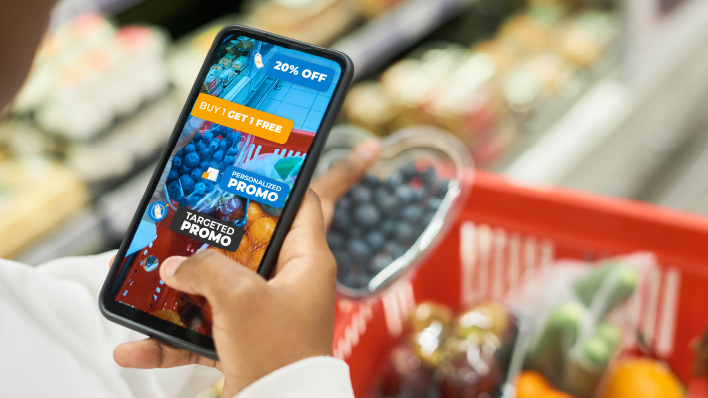Targeted promotions have proven to be a game-changer for the shopping experience, impacting both customers and retailers alike.
When targeted promotions are executed successfully, retailers can expect to influence shopping behavior, increase sales, and create more lifetime loyal customers.
According to Forbes, “About 91% of consumers are more encouraged to purchase when a brand personalizes its communication with them.”
Types of promotion methods
There are two promotion methods to be aware of: mass and targeted promotions. Though both have the same goal of driving leads and sales, their methods of achieving that goal are different.
Mass promotions vs targeted promotions
Mass pomotions focuses on marketing a product or service to a retailer’s entire customer base. It is not niche-exclusive.
Targeted promotions identify a specifically defined and profiled audience that they believe will purchase a specific product.
A deeper dive into targeted promotions
Now that we understand the basic definition of what targeted promotions are, let’s focus on the different levels of targeted promotions, types of mediums, and how they are created.
When creating targeted promotions, there are different levels retailers can tap into:
- Psychographic: Beliefs, values, lifestyle, occupation, interests
- Geographic: Region, city, neighborhood, area code, county, climate
- Demographic: Gender, age, education, religion, race, marital status
- Behavioral: Purchasing habits, brand interactions
Examples of medium types:
- Social platforms
- Mobile app
- Web ads
- Store signage
- Store display
- Print ads
- Direct mail ads
- Search engine ads
- Product placement
- Podcast/ radio / streaming services ad
How to create targeted promotions:
When creating targeted promotions, retailers create specific segments and rules.
Segmentation involves grouping customers based on their product preferences (ex: new visitors versus loyal shoppers, athletes versus gamers) as each segment will buy different products or react to different promotions.
Examples of targeted promotions
- Specific customer
- Region
- Store
Why targeted promotions are beneficial for retailers
Influence the right consumer
Targeted promotions are able to engage the right users at the right time and place. This increases the chance of a consumer purchasing a product on promotion because it aligns with their specific needs, wants, or values.
Foster customer loyalty
Clients are more likely to identify a retailer as unique from competitors if they offer promotions that meet the shoppers specific expectations. This increases customer loyalty, gaining the retailer a customer who will buy from that location again and again.
Save money on promotional spending & generate higher ROI
Promotions created for a specific audience can result in higher conversion rates, save budget as you are not targeting the wrong customers, and overall generate increased revenue.
Why the sudden interest in targeted promotions?
Targeted promotions have long been around for retailers but what really sparked the interest was the omnichannel revolution influenced by Covid-19.
With less time spent in brick-and-mortar stores and more time online shopping during the pandemic, consumer behavior started to change in just a matter of twelve months.
Retailers soon discovered that online shopping platforms have capabilities to collect customer-level data that is often lost at the POS level within a store.
As mentioned in our previous targeted promotions article, “Online shopping platforms can track past purchases, view substitutions the consumers made within their online cart, monitor items removed from their cart, and more. This impressive amount of data allows retailers to see into their consumers’ brains in ways they couldn’t have done with in-person shopping. The result? A need for more sophisticated targeted promotions.”
How AI and ML improve targeted promotion strategies
Targeted promotions are considered a top priority for retailers. However, with the tools and processes used today, it can be difficult for retailers to optimize their targeted promotions. This often leads to retailers relying on their tried and true method– going after their entire customer base.
To paint you a clearer picture as to why retailers default to mass promotions:
A grocery store with ~100 locations faces over 1.25 trillion decisions for targeted promotions. Without tapping into advanced technology, it is near impossible to feel confident that the promotion a retailer chose to run will perform the best.
Implementing advanced technology is essential for sophisticated and effective targeted promotions. With advanced technology, retailers can better connect, collect, and plan for more data.
But it’s not just about collecting the data and implementing advantaged technology…
Retailers also need to think about scalability and models that are specifically trained for their use cases.
Scalability
Invest in a cloud-native solution that can be scaled to manage the large data sets at the lowest levels of granularity (digital shoppers data, loyalty customer data, demographics data, etc.)
Trained ML/AI models
The number of decisions for targeted promotions reaches trillions. Successful targeting and analysis can only be achieved by leveraging the latest technology and trained ML/AI models
When scalability and trained models have been considered, AI and ML have the capabilities to:
Collect & connect data
Connect customer and product data across all channels such as digital, loyalty, demographic, transaction, and third-party data.
By having access to this amount of data and leveraging advanced technology to process and analyze, retailers know what product to promote and how they will promote it to their target audience.
Forecast and measure results
Predict, measure, and modify promotions in order for the retailer to select the promotion that best contributes towards their objectives.
With the help of advanced technology, retailers are able to increase customer loyalty with relevant personalized promotions while also meeting business objectives.

